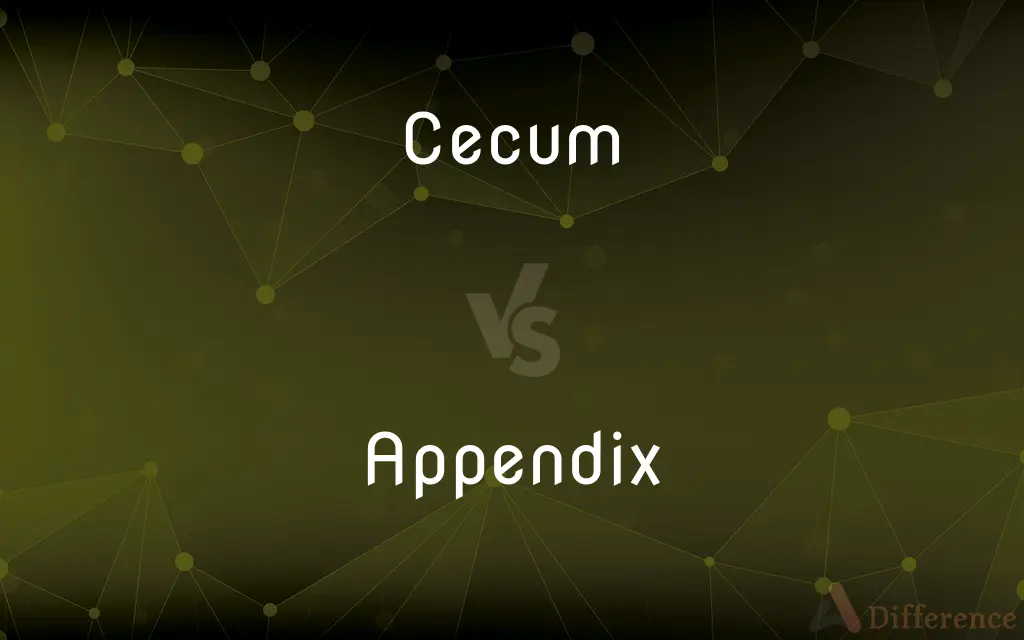Cecum vs. Appendix — What's the Difference?
By Tayyaba Rehman & Maham Liaqat — Updated on April 15, 2024
The cecum is a large pouch forming the beginning of the large intestine, whereas the appendix is a small, tube-like sac attached to the cecum.

Difference Between Cecum and Appendix
Table of Contents
ADVERTISEMENT
Key Differences
The cecum is a crucial part of the large intestine located at the junction where the small intestine meets the large intestine. It primarily functions in the absorption of fluids and salts after digestion. On the other hand, the appendix is a narrow, worm-like appendage attached to the cecum, whose function has been a topic of debate but is suggested to play a role in the immune system.
In terms of evolutionary biology, the cecum is well-developed in herbivorous animals, aiding in the digestion of cellulose and other plant fibers through bacterial fermentation. In contrast, the human appendix is considered a vestigial part, suggesting a diminished function compared to its ancestral purpose.
From a clinical perspective, the cecum is relatively less involved in common medical conditions, except for cases like cecal volvulus or tumors. Conversely, the appendix is commonly associated with appendicitis, an inflammation that can lead to severe complications if not treated promptly.
In surgical procedures, treatment involving the cecum can be more complex and varies depending on the condition, such as removal for cancer or correction for volvulus. However, removal of the appendix, known as an appendectomy, is a more common and straightforward procedure.
Regarding location within the abdominal cavity, the cecum is typically found in the lower right quadrant where the ileum of the small intestine attaches. The appendix, although variable in position, generally extends from the lower part of the cecum.
ADVERTISEMENT
Comparison Chart
Function
Absorbs fluids, houses beneficial bacteria
Possible immune function, vestigial
Evolutionary Role
Digestive in herbivores
Vestigial, less functional in humans
Common Conditions
Cecal volvulus, tumors
Appendicitis
Surgical Treatment
Depends on condition, can be complex
Usually appendectomy, straightforward
Location in Body
Lower right quadrant, start of large intestine
Extends from cecum, variable position
Compare with Definitions
Cecum
A pouch connected to the junction of the small and large intestines.
The cecum plays a role in the digestive process by absorbing fluids.
Appendix
A small tube-like structure extending from the cecum.
The appendix can become inflamed, leading to appendicitis.
Cecum
The first section of the large intestine.
Food residues enter the cecum from the ileum of the small intestine.
Appendix
Considered vestigial in humans.
Unlike other organs, the appendix has no significant known digestive function.
Cecum
Surgical interventions may vary.
Cecum removal can be necessary in cases of cancer.
Appendix
Common site for acute medical emergencies.
Appendicitis is a frequent emergency that necessitates surgical removal of the appendix.
Cecum
Involved in microbial fermentation of cellulose in herbivores.
In rabbits, the cecum helps in digesting cellulose.
Appendix
Removal is generally straightforward.
An appendectomy is often performed laparoscopically.
Cecum
Less prone to common diseases in humans.
Cecal volvulus, though rare, requires immediate surgical intervention.
Appendix
Position can vary significantly among individuals.
The appendix can be located in different positions, which may complicate diagnosis.
Cecum
The cecum or caecum is a pouch within the peritoneum that is considered to be the beginning of the large intestine. It is typically located on the right side of the body (the same side of the body as the appendix, to which it is joined).
Appendix
An appendage.
Cecum
(Anatomy)The large pouch at the beginning of the large intestine, located in the lower right-hand side of the abdomen. Also called blind gut.
Appendix
A collection of supplementary material, usually at the end of a book.
Cecum
A sac or bodily cavity with only one opening.
Appendix
(Anatomy) Any of several supplementary or accessory parts of a bodily organ or structure, especially the vermiform appendix of the large intestine.
Cecum
(American spelling) caecum
Appendix
Something attached to something else; an attachment or accompaniment.
Cecum
The caecum, the cavity in which the large intestine begins and into which the ileum opens.
Appendix
A text added to the end of a book or an article, containing additional information.
Cecum
The cavity in which the large intestine begins and into which the ileum opens;
The appendix is an offshoot of the cecum
Appendix
(anatomy) The vermiform appendix.
Appendix
(anatomy) Any process, prolongation, or projection.
Appendix
Something appended or added; an appendage, adjunct, or concomitant.
Normandy became an appendix to England.
Appendix
Any literary matter added to a book, but not necessarily essential to its completeness, and thus distinguished from supplement, which is intended to supply deficiencies and correct inaccuracies.
Appendix
The vermiform appendix.
Appendix
Supplementary material that is collected and appended at the back of a book
Appendix
A vestigial process that extends from the lower end of the cecum and that resembles a small pouch
Common Curiosities
What is the main function of the cecum?
The main function of the cecum is to absorb fluids and salts from digested foods and provide a space for fermentation in certain animals.
Can you live without a cecum or appendix?
Yes, people can live without both the cecum and appendix, although removal of the cecum usually occurs due to specific medical conditions.
What is the purpose of the appendix in humans?
The appendix is considered vestigial, but it may have roles in the immune system.
What causes appendicitis?
Appendicitis is typically caused by a blockage of the appendix leading to infection.
What are the risks of cecal surgery?
Cecal surgery can vary in complexity and risks depending on the underlying condition, such as cancer or volvulus.
What is a vestigial organ?
A vestigial organ is an organ that has lost most or all of its ancestral function in a particular species, such as the human appendix.
Where is the cecum located?
The cecum is located in the lower right quadrant of the abdomen, where the small and large intestines meet.
How common is cecal volvulus compared to appendicitis?
Cecal volvulus is less common than appendicitis, but it is a serious condition that can require surgical intervention.
Can the position of the appendix affect the symptoms of appendicitis?
Yes, the position of the appendix can affect symptoms and sometimes complicates the diagnosis of appendicitis.
Is there any dietary advice to maintain a healthy cecum and appendix?
While specific diets for the cecum and appendix aren't usually prescribed, a high-fiber diet benefits overall digestive health.
Can animals have appendicitis?
Animals such as rabbits have a well-developed cecum but do not have an appendix like humans; thus, they do not experience appendicitis.
How does the function of the cecum compare to the appendix?
The cecum has a significant digestive function, especially in fluid absorption, unlike the appendix, which has a minimal role, if any, in digestion.
Is appendicitis treatable?
Yes, appendicitis is commonly treated with surgery to remove the inflamed appendix.
What happens during an appendectomy?
During an appendectomy, the appendix is surgically removed to treat or prevent a rupture.
Share Your Discovery

Previous Comparison
Starch vs. Cellulose
Next Comparison
Flavour vs. AromaAuthor Spotlight
Written by
Tayyaba RehmanTayyaba Rehman is a distinguished writer, currently serving as a primary contributor to askdifference.com. As a researcher in semantics and etymology, Tayyaba's passion for the complexity of languages and their distinctions has found a perfect home on the platform. Tayyaba delves into the intricacies of language, distinguishing between commonly confused words and phrases, thereby providing clarity for readers worldwide.
Co-written by
Maham Liaqat













































